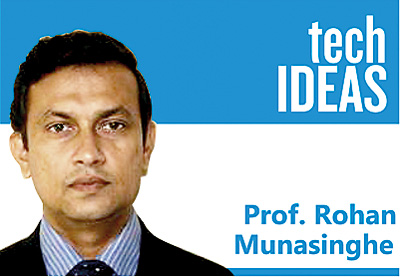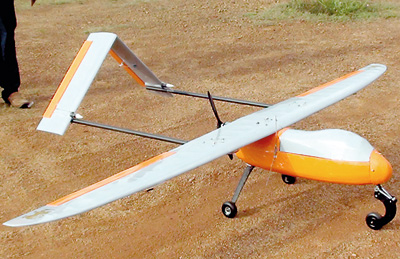Robotics at the University of Moratuwa
View(s):GRIN Technologies – Genetics, Robotics, Information technology, and Nanotechnology are recognised as the driving technologies of the world today. Developed countries make very good use of these technologies to maintain their development, while developing countries are trying to introduce these technologies into their production processes in order to speed up their development. It is in this context that the Department of Electronic and Telecommunication Engineering of the University of Moratuwa took the initiative back in 2005, to introduce Robotics to Sri Lanka.
 The Department of Electronic and Telecommunication Engineering added Robotics into the B.Sc. Engineering Degree Program of the University of Moratuwa in 2006 by introducing a new course module titled “Robot Design Competition”. In this course module, lectures were laboratory classes conducted to teach students almost all the aspects of a small fully autonomous robot including platform design, electronic control system, sensors, actuators, and the power system. During the later six weeks of the semester, students formed small four-student groups and actually built their own robots, competing against each other in a final competition. This course module, which is less theoretical and more skill development, has been very popular among students. In 2007, another course module by the title “Robotics” was introduced to the same degree programme. This course taught the theory and practical aspects of industrial robot manipulators that are used in automated industries in various applications such as welding, painting, cutting, palletising, etc. The purpose of the course was to produce engineers with the knowledge and skills required to set-up, operate, and maintain robotic manufacturing systems that would be introduced to Sri Lankan manufacturing industries in due course. Over the last eight years, we have produced about 250 engineers with knowledge and skills in robotics. I am sure that these engineers will take the initiative and accomplish the job of introducing robotics in Sri Lankan industries.
The Department of Electronic and Telecommunication Engineering added Robotics into the B.Sc. Engineering Degree Program of the University of Moratuwa in 2006 by introducing a new course module titled “Robot Design Competition”. In this course module, lectures were laboratory classes conducted to teach students almost all the aspects of a small fully autonomous robot including platform design, electronic control system, sensors, actuators, and the power system. During the later six weeks of the semester, students formed small four-student groups and actually built their own robots, competing against each other in a final competition. This course module, which is less theoretical and more skill development, has been very popular among students. In 2007, another course module by the title “Robotics” was introduced to the same degree programme. This course taught the theory and practical aspects of industrial robot manipulators that are used in automated industries in various applications such as welding, painting, cutting, palletising, etc. The purpose of the course was to produce engineers with the knowledge and skills required to set-up, operate, and maintain robotic manufacturing systems that would be introduced to Sri Lankan manufacturing industries in due course. Over the last eight years, we have produced about 250 engineers with knowledge and skills in robotics. I am sure that these engineers will take the initiative and accomplish the job of introducing robotics in Sri Lankan industries.
 Robotics is a fascinating technology, and it can be used in many application areas. The Department of Electronic and Telecommunication Engineering extended its robotics programme to the application area of unmanned aerial vehicles (UAV) in 2012. With robotics technology at hand, it was no difficult a task to design and build unmanned aerial vehicles. The first locally built UAV with autopilot control named RAVAN (Robotic Aerial Vehicle with Autonomous Navigation) was built in 2013 by four students while studying in their degree programme. Till today, it has flown 70 flights successfully, with a single no-damage crash. In 2011, we had our first four-student robotics group develop our own autopilot controller and tested it successfully on a very small 1.2kg plane.
Robotics is a fascinating technology, and it can be used in many application areas. The Department of Electronic and Telecommunication Engineering extended its robotics programme to the application area of unmanned aerial vehicles (UAV) in 2012. With robotics technology at hand, it was no difficult a task to design and build unmanned aerial vehicles. The first locally built UAV with autopilot control named RAVAN (Robotic Aerial Vehicle with Autonomous Navigation) was built in 2013 by four students while studying in their degree programme. Till today, it has flown 70 flights successfully, with a single no-damage crash. In 2011, we had our first four-student robotics group develop our own autopilot controller and tested it successfully on a very small 1.2kg plane.
The second robotics student group in 2012 used that autopilot to give RAVAN, which is 7.8Kg in weight, autonomous flying capability. The robotic aerial vehicle technology that we developed in the RAVAN project was used in 2015 to build our second UAV named CeyHawk (Ceylon Hawk) with the intention of commercialising it as a high-tech robotic product from Sri Lanka to the world. CeyHawk was designed with a much better appearance, and aerodynamic performance, to suit the international market. At present, we are completing the mould making for mass manufacturing CeyHawk. Both these robotic aerial vehicle systems are equipped with real-time video transmission to ground station, recording high definition video on board, position indicator on Google Maps, and flying status and power monitoring; thus, being ready to be deployed for missions such as urban traffic monitoring, aerial surveillance of national parks, disaster management, remote sensing, and for aerial monitoring in agriculture.
 Our Robotics team at the University of Moratuwa started developing an underwater robot as a pilot project to test the feasibility of getting into underwater robotics, which is a new area of research and development in Sri Lanka. The task of building our first underwater robot was undertaken by four B.Sc. Engineering undergraduates last year. The robot was designed to reduce fluid friction in motion, and it was equipped with four underwater thrusters, control and communication equipment needed to move in water under remote control.
Our Robotics team at the University of Moratuwa started developing an underwater robot as a pilot project to test the feasibility of getting into underwater robotics, which is a new area of research and development in Sri Lanka. The task of building our first underwater robot was undertaken by four B.Sc. Engineering undergraduates last year. The robot was designed to reduce fluid friction in motion, and it was equipped with four underwater thrusters, control and communication equipment needed to move in water under remote control.
Remote commands issued by the user are received by a floating unit, which sends the same commands to the underwater robot through a cable. The robot was initially tested in a pool for controller tuning and systems optimisation, and later the robot was tested in Bolgoda Lake. This robot is also equipped with a video camera to capture underwater videos. This project is now continuing into its second phase, in that we intend to develop autonomous capability for the robot. In the future, we hope to deploy our own underwater robots for underwater search, mapping, and surveillance. We also intend to commercially produce underwater robots targetting the international market.
Recently, we have started collaborating with the industry in helping to take robotics technology into the manufacturing industry. The textile and garment industry in Sri Lanka is specially facing a difficult time without high-tech support. We are also in contact with other industry partners who need robotics technology to maintain their market competitiveness.
(The writer is the Head of the Department of Electronic and Telecommunication Engineering, University of Moratuwa. He earned his PhD from Saga University, Japan, in 2003. He was a research fellow in KAIST-Stanford Research Collaborative Research Program in 2004. He is presently a Senior Member of IEEE, Institute of Electrical and Electronic Engineers, USA. He can be emailed at rohanm@uom.lk)


